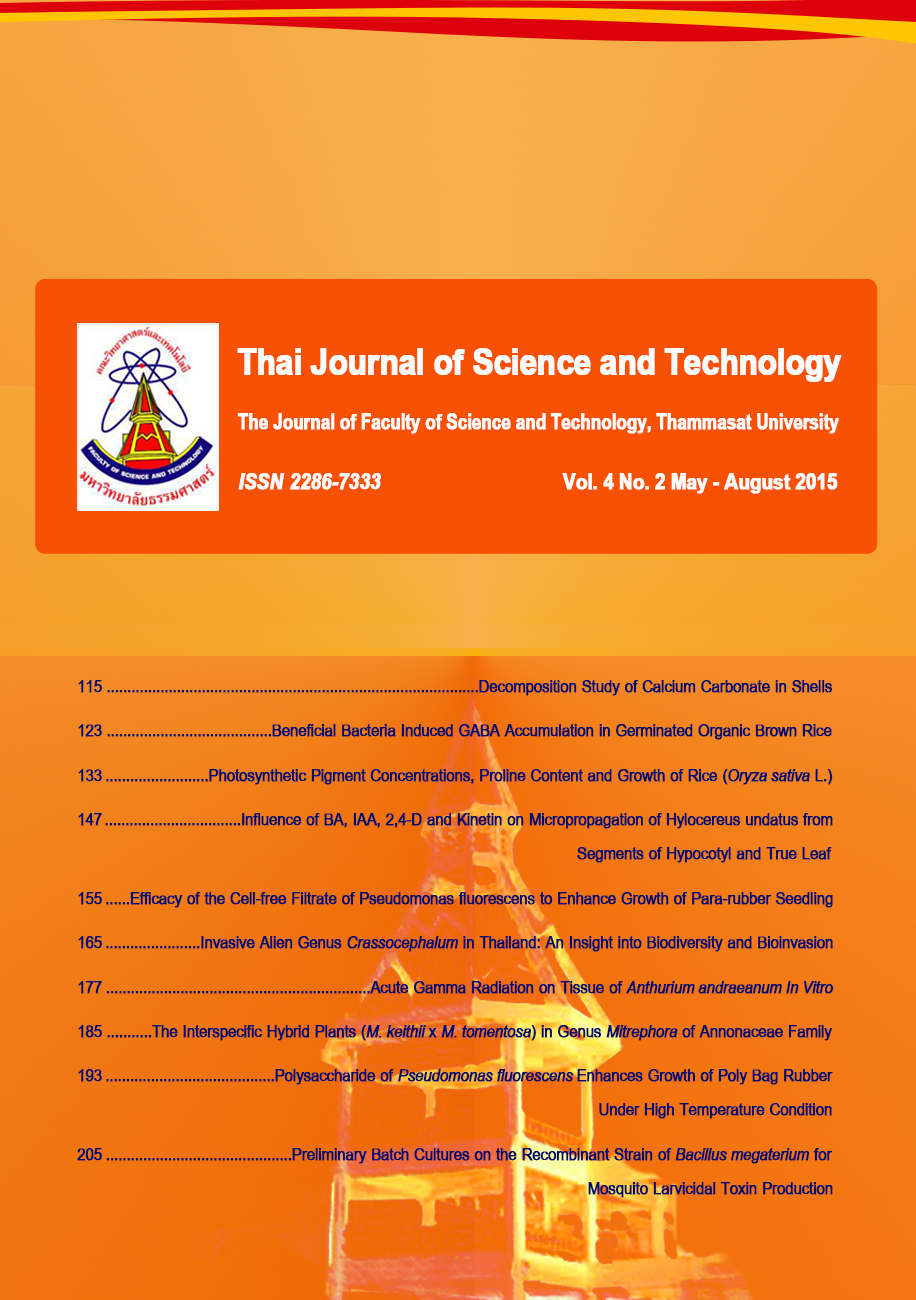ผลของสภาวะขาดน้ำต่อการรั่วไหลของสารอิเล็กโทรไลต์ ปริมาณรงควัตถุ ปริมาณโพรลีน และการเจริญเติบโตของข้าว
Main Article Content
Abstract
บทคัดย่อ
การศึกษาครั้งนี้มีวัตถุประสงค์เพื่อศึกษาการรั่วไหลของสารอิเล็กโทรไลต์ ปริมาณรงควัตถุ ปริมาณ โพรลีน และการเจริญเติบโตของข้าวที่ตอบสนองต่อสภาวะขาดน้ำ โดยนำต้นกล้าข้าวที่มีอายุ 28 วัน จำนวน 5 พันธุ์ ได้แก่ ปทุมธานี 1 ขาวดอกมะลิ 105 กข 31 กข 41 และ กข 47 มาทดลองงดให้น้ำเป็นเวลา 10 วัน จากการศึกษาพบว่าสภาวะขาดน้ำมีผลทำให้การรั่วไหลของสารอิเล็กโทรไลต์ภายในรากและใบเพิ่มขึ้นอย่างมีนัยสำคัญยิ่งทางสถิติ เมื่อเปรียบเทียบกับการให้น้ำปกติ รวมทั้งพบว่าการรั่วไหลของสารอิเล็กโทรไลต์ภายในรากมีความสัมพันธ์เชิงบวกกับการรั่วไหลของสารอิเล็กโทรไลต์ภายในใบ (r2 = 0.76) ในทางกลับกัน พบว่า สภาวะขาดน้ำส่งผลทำให้ปริมาณรงควัตถุภายในใบ ได้แก่ คลอโรฟิลล์เอ คลอโรฟิลล์บี คลอโรฟิลล์ทั้งหมด และแคโรทีนอยด์ทั้งหมดลดลง นอกจากนี้ยังพบว่าปริมาณคลอโรฟิลล์ทั้งหมดภายในใบมีความสัมพันธ์เชิงบวกกับน้ำหนักแห้ง (r2 = 0.72) ซึ่งมีผลทำให้การเจริญเติบโตของข้าวทั้ง 5 พันธุ์ ลดลง ส่วนปริมาณโพรลีนภายในรากและใบเพิ่มขึ้นอย่างมีนัยสำคัญยิ่งทางสถิติเมื่อได้รับสภาวะขาดน้ำ จากการศึกษาครั้งนี้สามารถนำค่าการรั่วไหลของสารอิเล็กโทรไลต์ภายในใบ ปริมาณคลอโรฟิลล์ทั้งหมด และปริมาณโพรลีนภายในใบมาใช้ในการจำแนกความสามารถในการทนทานต่อสภาวะขาดน้ำในระยะต้นกล้าของข้าวได้ 2 กลุ่ม คือ พันธุ์ข้าวที่ทนทานต่อสภาวะขาดน้ำ ได้แก่ ขาวดอกมะลิ105 กข 31 และ กข 47 และพันธุ์ข้าวที่อ่อนแอต่อสภาวะขาดน้ำ ได้แก่ ปทุมธานี 1 และ กข 41
คำสำคัญ : ข้าว; สรีรวิทยา; ขาดน้ำ; รงควัตถุ
Abstract
This study aims to investigate the electrolyte leakage, photosynthetic pigment concentrations, proline content and growth of rice responses to drought stress. Twenty-eight days seedlings of five rice cultivars including; Pathumthani1, Khao Dawk Mali 105, RD31, RD41 and RD47 were exposed to drought stress for 10 days. The results showed that the drought stress was significantly enhanced the electrolyte leakage in roots and leaves when compared to well-watered. Moreover, this study found that the electrolyte leakage in roots was positively related to the electrolyte leakage in leaves (r2 = 0.76). In contrast, the photosynthetic pigment concentrations including; chlorophyll a (Chl a), chlorophyll b (Chl b), total chlorophyll (TC) and total carotenoids (Cx+c) were reduced by drought stress. Furthermore, the total chlorophyll was positively related to the dry weight (r2 = 0.72), leading to the growth reduction of five rice cultivars. In addition, the proline content in roots and leaves were significantly increased when subjected to drought stress. From this study showed that the physiological characteristic responses may be used to classify the drought tolerance of rice in the seedling stage. From this study, the physiological characteristic responses of rice on drought stress can be used to identify the drought tolerance ability of rice in seedling stage into 2 groups including; drought tolerance (Khao Dawk Mali 105, RD31 and RD47) and sensitive-drought tolerance rice (Pathumthani 1 and RD41).
Keywords: rice; physiology; drought; pigment
Article Details
บทความที่ได้รับการตีพิมพ์เป็นลิขสิทธิ์ของคณะวิทยาศาสตร์และเทคโนโลยี มหาวิทยาลัยธรรมศาสตร์ ข้อความที่ปรากฏในแต่ละเรื่องของวารสารเล่มนี้เป็นเพียงความเห็นส่วนตัวของผู้เขียน ไม่มีความเกี่ยวข้องกับคณะวิทยาศาสตร์และเทคโนโลยี หรือคณาจารย์ท่านอื่นในมหาวิทยาลัยธรรมศาสตร์ ผู้เขียนต้องยืนยันว่าความรับผิดชอบต่อทุกข้อความที่นำเสนอไว้ในบทความของตน หากมีข้อผิดพลาดหรือความไม่ถูกต้องใด ๆ


